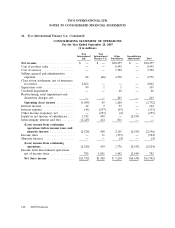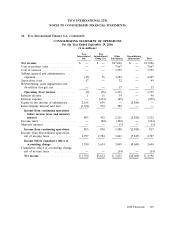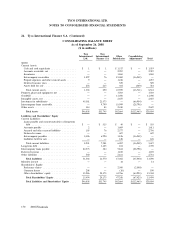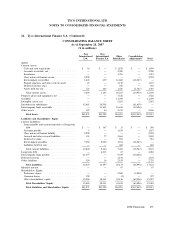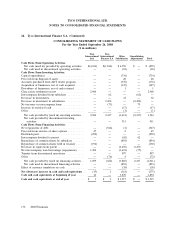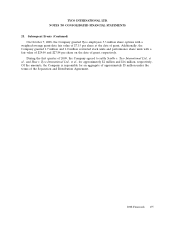ADT 2008 Annual Report Download - page 281
Download and view the complete annual report
Please find page 281 of the 2008 ADT annual report below. You can navigate through the pages in the report by either clicking on the pages listed below, or by using the keyword search tool below to find specific information within the annual report.
2007 ORGANIC REVENUE GROWTH
ORGANIC ORGANIC
2006 NET ACQUISITION / FOREIGN REVENUE 2007 NET REVENUE
( IN US$ MILLIONS ) REVENUES DIVESTITURE CURRENCY OTHER GROWTH REVENUES GROWTH %
ADT Worldwide $ 7,205 $ ( 3 ) $ 213 $ ( 21 ) $ 254 $ 7,648 3.5%
Flow Control 3,135 ( 16 ) 197 — 450 3,766 14.4%
Fire Protection Services 3,150 ( 30 ) 101 — 145 3,366 4.6%
Electrical & Metal Products 1,949 1 20 — 4 1,974 0.2%
Safety Products 1,624 — 49 — 46 1,719 2.8%
Corporate and Other 3 — — — 1 4 33.3%
TOTAL $ 17,066 $ ( 48 ) $ 580 $ ( 21 ) $ 900 $ 18,477 5.3%
2008 ORGANIC REVENUE GROWTH
ORGANIC ORGANIC
2007 NET ACQUISITION / FOREIGN REVENUE 2008 NET REVENUE
( IN US$ MILLIONS ) REVENUES DIVESTITURE CURRENCY OTHER GROWTH REVENUES GROWTH %
ADT Worldwide $ 7,648 $ 49 $ 213 $ ( 22 ) $ 129 $ 8,017 1.7%
Flow Control 3,766 16 314 ( 10 ) 332 4,418 8.8%
Fire Protection Services 3,366 — 125 — 62 3,553 1.8%
Electrical & Metal Products 1,974 1 44 — 253 2,272 12.8%
Safety Products 1,719 1 76 — 138 1,934 8.0%
Corporate and Other 4 — — — 1 5 25.0%
TOTAL $ 18,477 $ 67 $ 772 $ ( 32 ) $ 915 $ 20,199 5.0%
2006 ORGANIC REVENUE GROWTH
ORGANIC ORGANIC
2005 NET ACQUISITION / FOREIGN REVENUE 2006 NET REVENUE
( IN US$ MILLIONS ) REVENUES DIVESTITURE CURRENCY GROWTH REVENUES GROWTH %
ADT Worldwide $ 7,104 $ ( 19 ) $ ( 35 ) $ 155 $ 7,205 2.2%
Flow Control 2,806 — ( 43 ) 372 3,135 13.3%
Fire Protection Services 3,053 ( 39 ) ( 12 ) 148 3,150 4.9%
Electrical & Metal Products 1,798 — 15 136 1,949 7.6%
Safety Products 1,621 ( 56 ) ( 2 ) 61 1,624 3.8%
Corporate and Other 3 — — — 3 —
TOTAL $ 16,385 $ ( 114 ) $ ( 77 ) $ 872 $ 17,066 5.3%
NON-GAAP MEASURES
“Organic revenue growth,” “operating margin before special items,” “income from continuing
operations before special items,” and “diluted EPS from continuing operations before
special items” are non-GAAP measures and should not be considered replacements for
GAAP results.
Organic revenue growth is a useful measure used by the company to measure the underlying
results and trends in the business. The dierence between reported net revenue growth (the
most comparable GAAP measure) and organic revenue growth (the non-GAAP measure)
consists of the impact from foreign currency, acquisitions and divestitures, and other changes
that do not relect the underlying results and trends. Organic revenue growth is a useful
measure of the company’s performance because it excludes items that: i) are not completely
under management’s control, such as the impact of foreign currency exchange; or ii) do not
relect the underlying growth of the company, such as acquisition and divestiture activity.
It may be used as a component of the company’s compensation programs. The limitation
of this measure is that it excludes items that have an impact on the company’s revenue.
This limitation is best addressed by using organic revenue growth in combination with the
GAAP numbers.
The company has presented its, operating margin, income from continuing operations and
diluted EPS from continuing operations before special items. Special items include charges and
gains that may mask the underlying operating results and/or business trends of the company
or business segment, as applicable. The company utilizes these inancial measures before
special items to assess overall operating performance and segment-level core operating per-
formance, and to provide insight to management in evaluating overall and segment operating
plan execution and underlying market conditions. Income from continuing operations before
special items may also be a signiicant component in the company’s incentive compensation
plans. Operating margin, income from continuing operations and diluted EPS from continuing
operations before special items are useful measures for investors because they permit
more meaningful comparisons of the company’s underlying operating results and business
trends between periods. The dierence between these measures and the most comparable
GAAP measures (operating margin, income from continuing operations and diluted EPS from
continuing operations) consists of the impact of charges and gains related to divestitures,
acquisitions, restructurings (including transaction costs related to the separations of Tyco
Electronics and Covidien into separate public companies), and other income or charges that
may mask the underlying operating results and/or business trends. The limitation of these
measures is that they exclude the impact (which may be material) of items that increase or
decrease the company’s reported operating income, operating margin and EPS from
continuing operations. This limitation is best addressed by using these inancial measures in
combination with the most comparable GAAP measures in order to better understand the
amounts, character and impact of any increase or decrease on reported results.


